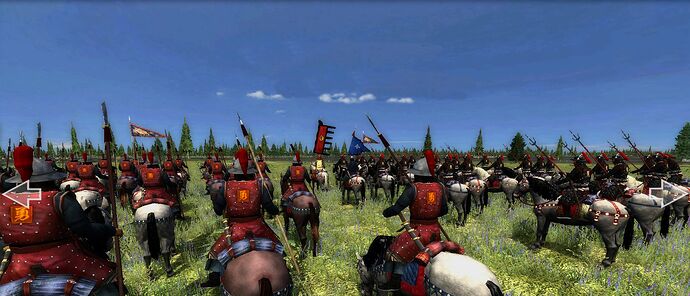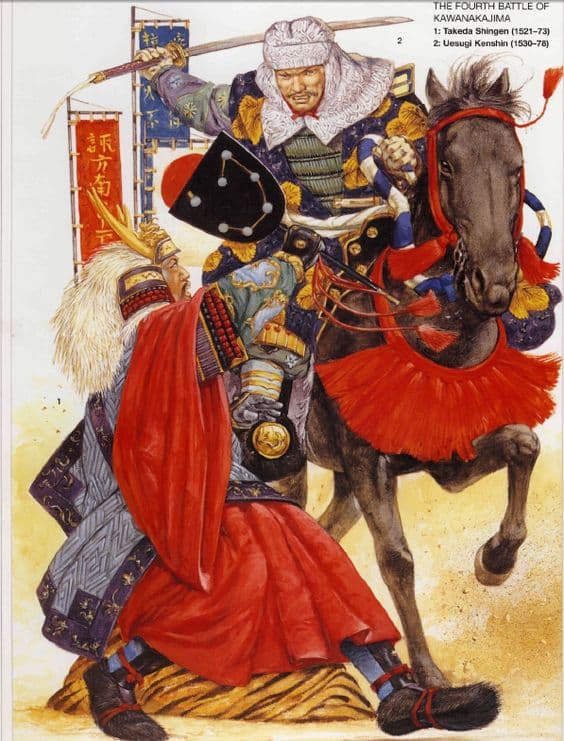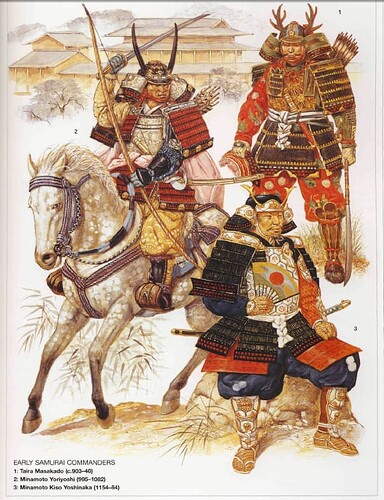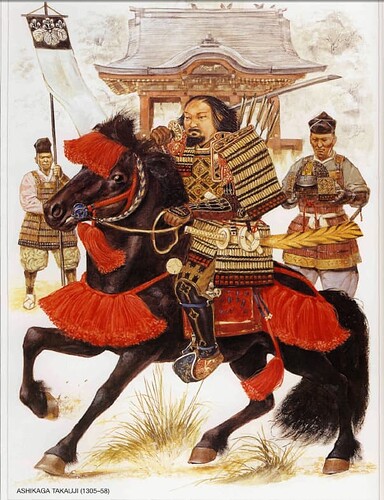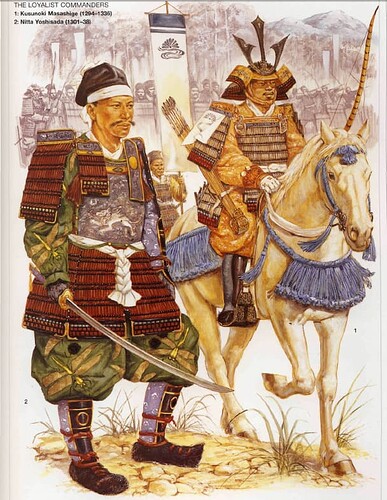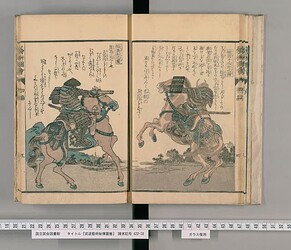While developers take lot of inspiration from real life history, which is great, but their primary goal is not to produce 100% accurate piece of work, but work that takes inspiration from real life and represent its in way that its enjoyable to user this includes things like making certain things read lot better or other changes that might alter the accuracy of historic things.
Historically speaking japan was split into many different clans and each clan had their own “units”. Generally the theme was similar, but each clan had its own things.
I did some research on this topic specifically and some sources claim that cavalry was not in favor in japan as much as it was in west and this is because the japanese breed of horses were weaker than european counterpart and horses were primary used for archery or archer platforms etc. (I do not claim that this is accurate, but this is what I read)
So essentially if we look at this logic then it would mean that japanese civ shouldn’t necessary even have the access to “heavy cavalry” or cavalry with shields?
That’s mostly true.
We already have less heavy cavalry-focused civs so Japan does not need to follow the standard roster. They could have a “medium cavalry” like Mali. Or a “heavy cavalry archer” as a unique unit. Rather than the same heavy charge cavalry with shield like everyone else.
And whatever role Japanese cavalry played, shields were universally rare for them. If you want to force a heavy charge cavalry unit, it had better not have hand-held shields, at least not round ones.
I think it’s good on the whole, but not evidence by itself that shields weren’t used. Like I said, Tate-style shields were a thing.
Circle shields were obviously not, or at least, were incredibly rare.
Tate are pavises. They are deployed by infantry as a stationary defense. Far from being a practical cavalry weapon.
There were Ghulam’s and Keshik’s in the screenshot. My interpretation is almost guaranteed they are having a Mercenary wonder or mechanic.
Maybe those are not Japanese either.
They have Naginata though
(there’s a bunch of interesting reading here, which I’m sure folks can cherry pick at their leisure - I’m not really interested in proving X or Y except that shields, even on cavalry, was a thing)
There are other sources, but this is one I was reading today. Not arguing that shields were popular, or that the visual design seen in AoE IV shouldn’t change, simply arguing that “no shields” is a myth too.
If anything, the wide range of accounts detailing the modifications to the different kinds of shields seen over the decades and centuries should be something the devs should lean into, instead of removing them entirely.
If anything, that should be tied to the campaign. The devs have clearly made choices to have very similar and recognizable units. It looks like the Japanese lancers have a slightly modified lance design, but it overall looks very similar to the Chinese and former Mongol lancers.
The new unit looks in the teaser for the DLC look awesome, and maybe we can have more historical/unique unit designs, but likely they will be limited to single player content.
Reliable sources all state that the naginata was a weapon mainly used in infantry combat. Its development is also closely related to the increase in the frequency of foot combat due to the increasing scale of wars in the Japanese Middle Ages. Also because it was an infantry weapon, when it fell out of favor with the military, it evolved into a defensive tool commonly used by monks and women, and then became one of their icons.
I think the reason why samurai were to use the naginata on horseback was most likely because they needed to enter foot combat at any time, so they had the naginata ready, or because they switched from foot combat to mounting and chasing, so they just continued to use it. Anyway, you also mentioned that should be rare. Paintings can be based on rare scenarios, but the design of in-game units should be based on the majority of situations.
Please let me share what I know about the history of Japanese weapons.
Before the Middle Ages, most of Japanese melee weapons were based on the styles of Chinese weapons at that time, such as the Chokuto, which was influenced by the Chinese straight swords, or the Hoko, which was based on the Chinese spears. On the other hand, Japanese original longbows, the Yumi, developed very early and began to have its own unique asymmetrical shape.
In the ancient time, the cavalry composed of nobles went into battle, and the mounted archery using the Yumi was a mainstream and a battle ritual. However, the war with the Emishi people began to change the ancient Japanese war pattern. The swords were influenced by the Emishi people and began to become curved, and Tachi came from this. Compared with the Chokuto, the tachi is curved and longer, suitable for cavalry use, so it became the standard equipment of samurai and had been used until the 16th century.
As the scale of the war increased, non-nobles also had to fight, and they did not have horses or could not use horses, so foot battles became more frequent, and the Tachi tended to have longer handles or blades. The Naginata evolved from the Hoko or Tachi and became a favorite pole weapon for infantry. In addition, the Odachi (or called Nodachi) and the Nagamaki, which also evolved from the Tachi, had become popular among infantry as they play roles similar to the Zweihänder.
In the 13th century, Chinese and Korean soldiers with the arrival of the Mongols allowed the Japanese at the border of the mainland Asia to see what the long-polearm formation was and its power in large-scale infantry battles. Around the 14th century, the Yari began to develop as a useful, cheap, and mass-produced polearm.
Entering the Sengoku Period, ordinary people were mobilized on a large scale to become low-level infantry, the Ashigaru. As the samurai pursued a better melee tool for facing large numbers of infantry, the Tachi began to shorten but more curved, and became the most famous type of Japanese sword, the Katana. At the same time, with the arrival of Western gunpowder, the Teppo (musket) began to be mass-produced and used. Weapons such as the Tachi, Naginata, Odachi, and Nagamaki were gradually withdrawing from the battlefield, replaced with the Katana, Yari and Teppo.
Only Yumi has continued to evolve and be used over thousands of years. Even as the scale of the war grew and the cavalry gave up archery in favor of charging with the Tachi and later the Yari, the infantry still used them as shooting weapons especially in support of the Teppo.
As for the Tate (shield), although it was recorded by the Chinese in the 3rd century that the commonly used weapons of the Japanese at that time were spears, shields and bows, shields do not seem to have become mainstream after that, because the Japanese used formations in battle much later than the rest of the world, and earlier began to use weapons in two hands for faster attacks and greater power. Over time, movable shelters similar to mantlets or pavises became mainstream of the Tate. It was a kind large wooden square shield placed in front of the front row of long-range infantry. Obviously, it was not as numerous as other weapons and could not be used by cavalry on horseback like kite shields or heater shields in Europe.
Tedate (hand shield), a kind of quite smaller wooden square shield, did exsit, but not mainstream. It was not a common equipment for samurai. It is also clearly stated in the Japanese wiki that Tedate became obsolete due to the need to use weapons with both hands and the development of armor. Samurai would use the armor’s large shoulder plates (ōsode, literally “large sleeve”) to act like a shield, and ashigaru would use their hats (jingasa) made from metal and leather as a shield when needed.
If the game need to design a cavalry for the Japanese, I don’t think they should put the Tedate there, just like there should not be the Naginata Riders. As I said, the design of in-game units should be based on the majority of situations.
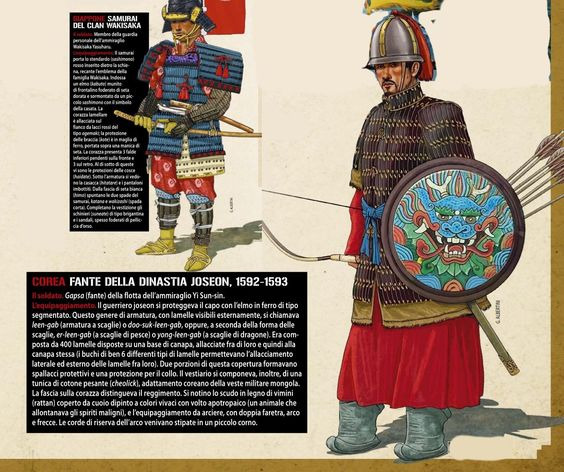
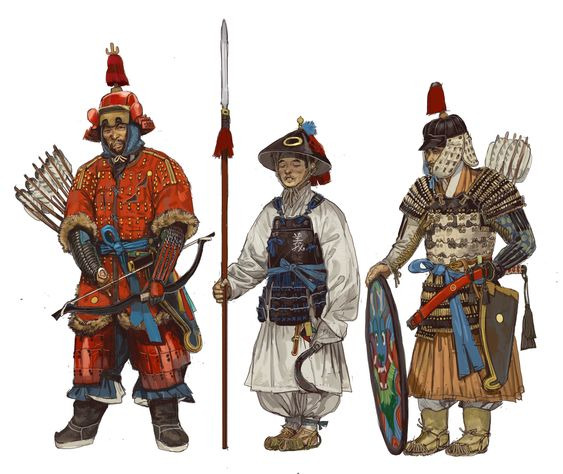
I found this while searching for anything close to a japanese cavalry using shields, sadly I don’t know the source for this image. So I don’t know if this is a japanese cavalrymen or a korean soldier scavanging japanese arms.
Meanwhile, these are from the Ospreys Man at Arms series:
The left one is a Japanese, and the right one is a Korean.
They are Chinese or Korean. No Japanese in the three, I think.
The rest pictures are all Japanese.
You can also find that those samurai did not use shields like the Tedate, but each of them wore armor with the Osode.
Their shields are tied to their armor.
Those square things on their shoulders are the shield of the Japanese units.
This is why they didn’t hold shields in their hand, but they wore them on their armor.
This is a huge difference that the developers need to understand.
Only then, the players will be immersed.
Otherwise, I cannot stand that silver Chinese round shield on these units.
This statement is a bit excessive. AoE3’s failure has its reasons, but not every part makes it a failure.
There are indeed quite a few units out there that serve the entertainment purpose of the game rather than accuracy, such as the British Longbow or the Chinese Flamethrower. Over the course of a dozen years, they became part of civilization, making it difficult to remove them on grounds of accuracy. However, it’s not too much of a request to have Naginata Rider use Yari instead, that’s just reskinning and renaming.
At least AoE3 doesn’t emphasize that Naginata Rider has a shield on his hand. The Japanese in AoE4 are a new civilization, so they should try to do better, rather than muddle along, or use inaccurate designs in other games as a reference.
Please stay on topic. Aoe3 has nothing to do with japanese not using shields.
Specifically, cavalry throughout East Asia are rarely equipped with shields, and they wield long pole weapons with both hands on horseback.
According to real history, Japanese CIVs should not even have LANCE cavalry/knights, because in the Middle Ages, their horses were very low and short. I don’t understand why Japanese cavalry had so many BUFFs, which is very absurd.
Japanese should rely of ashigaru footman and not mainly cavarly as the trailer show us. Even with this, Japanese in the trailer still anachronical, they shouldn’t wear hand round shield, western lance cavalary and pikes. Horses shouldn’t be that armored, look like cataphracts.
I see that I have not yet given an opinion on this topic, and in fact, it deserves its own topic of discussion.
ABOUT JAPANESE SHIELDS AND CAVALRY:
-
Indeed, the Japanese did NOT use shields in their cavalry, and generally not in their melee infantry either. Generally only the rangue infantry used square shields such as paveses, the famous tate, which was RECTANGULAR.
-
In the strange case that the cavalry used shields, they were the ones that were on their shoulders and were part of their armor, or else they were small “Square” and “Rectangular” shields, but not round.
-
The only round shields that could have been used were “wodden” rattan shields, imported from China, but they were not common, and in fact they were somewhat rare in medieval japan.
-
Shields were generally abandoned for much of the general Middle Ages for melee infantry, because swords, spears, and naginatas required two hands (at least that’s well represented in the game).
-
Only in the Sengoku era, with the advent of ########### harquebus firearms, was it considered creating shields to protect cavalry if the rider had enough skill to calculate the aim of the bullet and deflect it. But it was “Square” or “Rectangular”. Here is the reference image:
- “Some examples”
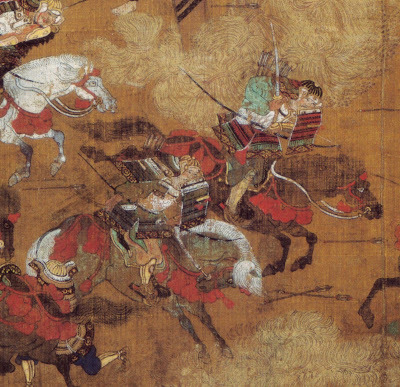
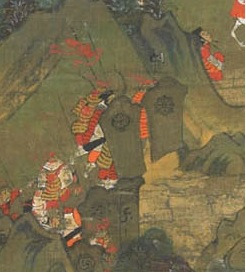
Rectangular shields, because were rectangular or square shields.
